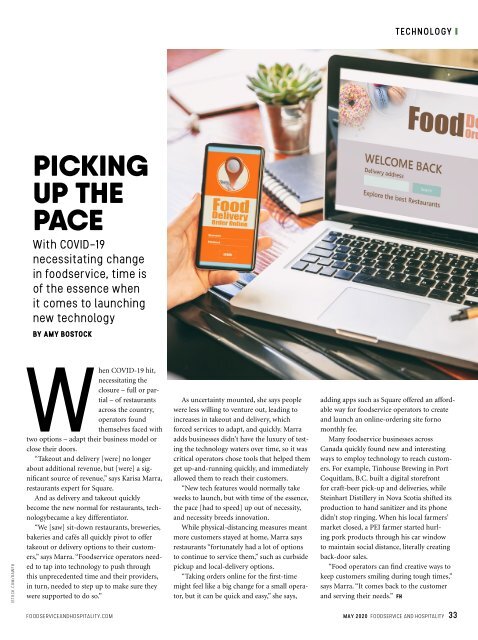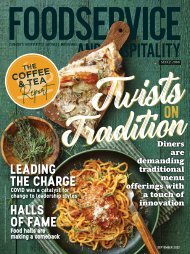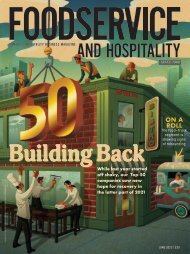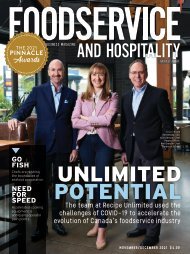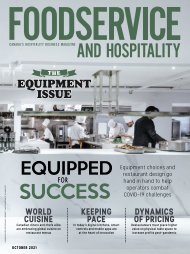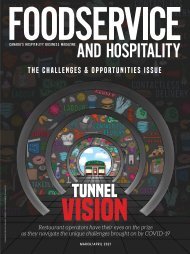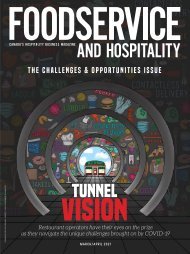May 2020
May 2020 issue of Foodservice and Hospitality magazine.
May 2020 issue of Foodservice and Hospitality magazine.
Create successful ePaper yourself
Turn your PDF publications into a flip-book with our unique Google optimized e-Paper software.
TECHNOLOGY<br />
PICKING<br />
UP THE<br />
PACE<br />
With COVID-19<br />
necessitating change<br />
in foodservice, time is<br />
of the essence when<br />
it comes to launching<br />
new technology<br />
BY AMY BOSTOCK<br />
ISTOCK.COM/RAWF8<br />
When COVID-19 hit,<br />
necessitating the<br />
closure – full or partial<br />
– of restaurants<br />
across the country,<br />
operators found<br />
themselves faced with<br />
two options – adapt their business model or<br />
close their doors.<br />
“Takeout and delivery [were] no longer<br />
about additional revenue, but [were] a significant<br />
source of revenue,” says Karisa Marra,<br />
restaurants expert for Square.<br />
And as delivery and takeout quickly<br />
become the new normal for restaurants, technologybecame<br />
a key differentiator.<br />
“We [saw] sit-down restaurants, breweries,<br />
bakeries and cafés all quickly pivot to offer<br />
takeout or delivery options to their customers,”<br />
says Marra. “Foodservice operators needed<br />
to tap into technology to push through<br />
this unprecedented time and their providers,<br />
in turn, needed to step up to make sure they<br />
were supported to do so.”<br />
As uncertainty mounted, she says people<br />
were less willing to venture out, leading to<br />
increases in takeout and delivery, which<br />
forced services to adapt, and quickly. Marra<br />
adds businesses didn’t have the luxury of testing<br />
the technology waters over time, so it was<br />
critical operators chose tools that helped them<br />
get up-and-running quickly, and immediately<br />
allowed them to reach their customers.<br />
“New tech features would normally take<br />
weeks to launch, but with time of the essence,<br />
the pace [had to speed] up out of necessity,<br />
and necessity breeds innovation.<br />
While physical-distancing measures meant<br />
more customers stayed at home, Marra says<br />
restaurants “fortunately had a lot of options<br />
to continue to service them,” such as curbside<br />
pickup and local-delivery options.<br />
“Taking orders online for the first-time<br />
might feel like a big change for a small operator,<br />
but it can be quick and easy,” she says,<br />
adding apps such as Square offered an affordable<br />
way for foodservice operators to create<br />
and launch an online-ordering site forno<br />
monthly fee.<br />
Many foodservice businesses across<br />
Canada quickly found new and interesting<br />
ways to employ technology to reach customers.<br />
For example, Tinhouse Brewing in Port<br />
Coquitlam, B.C. built a digital storefront<br />
for craft-beer pick-up and deliveries, while<br />
Steinhart Distillery in Nova Scotia shifted its<br />
production to hand sanitizer and its phone<br />
didn’t stop ringing. When his local farmers’<br />
market closed, a PEI farmer started hurling<br />
pork products through his car window<br />
to maintain social distance, literally creating<br />
back-door sales.<br />
“Food operators can find creative ways to<br />
keep customers smiling during tough times,”<br />
says Marra. “It comes back to the customer<br />
and serving their needs.” FH<br />
FOODSERVICEANDHOSPITALITY.COM<br />
MAY <strong>2020</strong> FOODSERVICE AND HOSPITALITY 33


